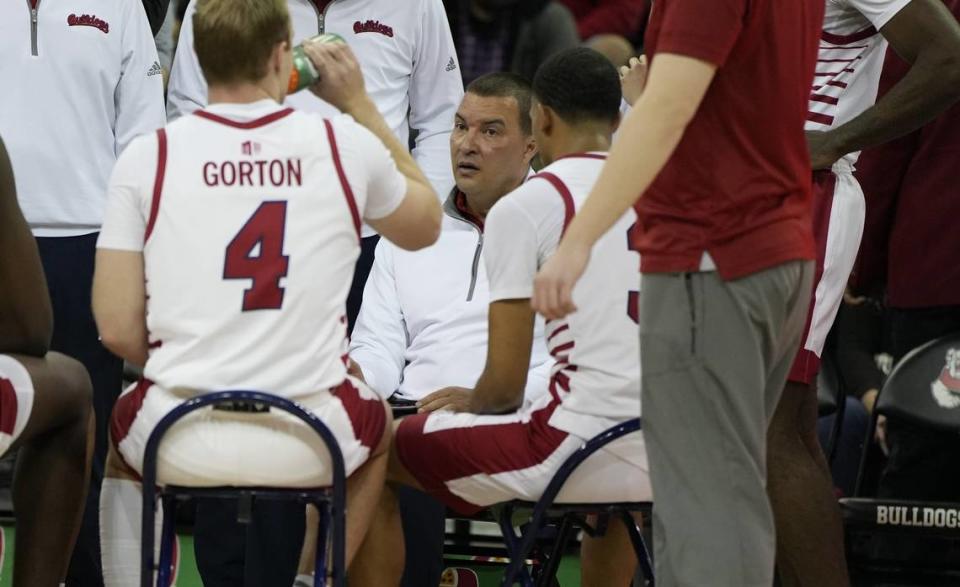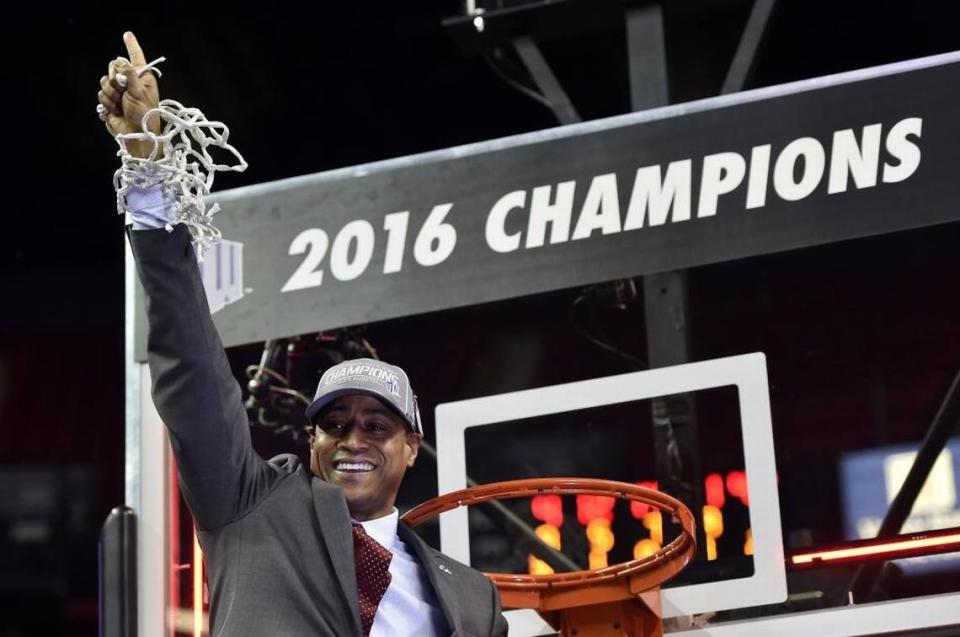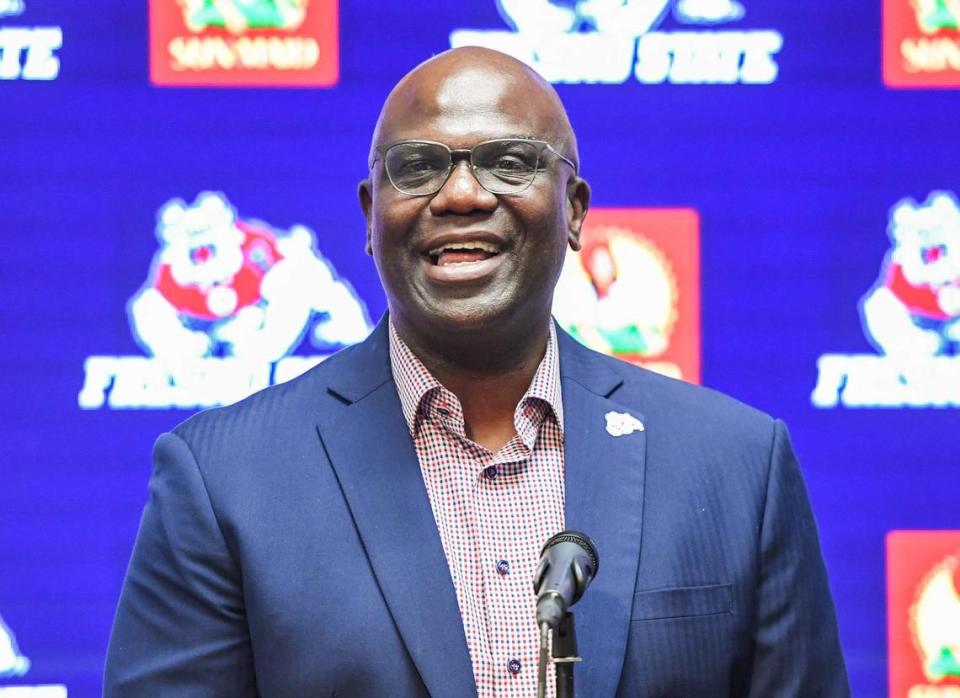Is the Save Mart Center killing Fresno State basketball? How home arena deal isn’t sweet
Fresno State basketball is reaching a tipping point 20 years in the making, and the most pressing questions when it comes to the long-term health of the program have nothing to do with a coach, but with revenue and revenue generation. Here is the big one: Is the Save Mart Center killing Fresno State basketball?
The Bulldogs since 2003 have played in a venue that was built on campus, but the athletics department has few avenues to pull revenue from the arena.

On top of that it has to pay to play and practice at the Save Mart Center, nearly $700,000 a year, and on game days is charged for everything from floor conversions to staff, security, housekeeping, utilities, first aid, liability insurance for every patron through the doors and on down to a 5-cent printing fee for tickets that go through its box office.
It is a double whammy to an athletics department keeping close tabs on every penny and during the COVID-19 pandemic dropped three sports due to rising costs.
“The initial funding model of the Save Mart Center has always made it extraordinarily difficult for the athletics department to generate basketball revenue streams that compare favorably to industry standards and are simply required to maintain and advance a contemporary Division I athletics program,” said former athletics director Thomas Boeh, who ran the department from 2005 to 2014.
That lack of revenue potential became far more acute when Fresno State joined the Mountain West and a conference membership that is more able to invest in basketball, which is illustrated by some chilling data.
The Bulldogs program in 2021-22 posted operating revenue of $1.6 million. That was about $3.3 million less than the average among the other nine public universities in the conference that submit an annual financial report to the NCAA, and about $7 million less than UNLV and San Diego State at the top of the conference.
That lack of revenue obviously is reflected in basketball investment, where the Bulldogs at $3.7 million ranked ninth in the Mountain West and were more than $1 million under the league average. San Diego State, which this season became the first Mountain West program to advance to the national championship game, invested around two times what Fresno State did in its basketball program.
But it also was a problem from the day the doors to the Save Mart Center opened, with revenues from the building including naming rights, sponsorships, suite leases, concessions sales and parking all pledged to the capital lease (debt) and the operating deficit.
A bad deal for the Bulldogs from the start
Fresno State hosted its first event at the Save Mart Center on Nov. 9, 2003, a volleyball match against Hawaii, which was ranked No. 2 in the nation. But the Bulldogs were back in the North Gym, their longtime home, for a final home match three days later and did not move into the Save Mart Center on a full-time basis until the 2007 season.
Simply, it couldn’t afford it.
“Why would we want to play San Jose State (at the Save Mart Center) when 700 people show up and we can’t pay the bills?” former athletics director Scott Johnson said, in a 2003 article in The Bee.
“It has been this way and that’s why, when there are leadership transitions in athletics, we try to share this to say, ‘It’s not ideal, but we also have a beautiful building that we wouldn’t have had otherwise, so how do we work together, how do we figure this out, where can we help?’” said Debbie Adishian-Astone, the university’s vice president for administration and finance, who has led several development projects on campus including the Save Mart Center.
But now, 20 years later, the lack of revenue and the costs associated with hosting around 45 games a year in the building have become a greater drag on the Bulldogs’ program.
Costs continue to go up, the competition keeps getting farther away.
“The first time you see the Save Mart Center from the outside you are impressed,” a former athletics official said. “When you understand what it does for the community as an entertainment venue you are pleased. When you find out it does not help Fresno State Athletics as a revenue stream, that is disappointing. No concessions, no parking monies and Fresno State athletics pays rent. That is difficult for athletics.”
And, no matter who is in the big chair in the basketball offices, the lack of revenues and corresponding lack of spending impacts scheduling, team travel, nutrition, recruiting, and staff stability. The program also lacks dedicated facilities for practice, weight training and medical treatment, which impacts player development.
Former Fresno State coach Rodney Terry made that clear in 2018 when taking a step backward in moving to Texas-El Paso, despite having two all-conference players set to return and still three years remaining on his contract.

“I love my team. I love what we have done with this program. I think we’ve taken it to another level,” Terry said, after coaching his final game at Fresno State. “Is there another level that we can go to? Yeah, there is another level, but there has to be a commitment behind the expectations.”
While dollars do not guarantee wins, they do allow for greater investment in factors that can drive success. And when basketball, a revenue-generating sport at many schools, is a significant money loser, it has a trickle-down impact on all of the Bulldogs’ athletics programs.
The Bulldogs women’s volleyball program has finished higher than fourth in the Mountain West just once since joining the conference in 2012 and last fall was 7-23, 1-17 in league play and in last place. The women’s basketball program has been on a steady decline, failing to advance to the NCAA Tournament nine seasons in a row now after making the Big Dance in seven consecutive years. It was 10-22 last season, 3-15 in conference play.
Are there additional avenues or more flexibility at the arena to better support the programs?
“There’s really not,” Adishian-Astone said. “I know the question comes up all the time about concessions and parking. Overall, with debt service and operating deficit, our auxiliary has to cover between $2 million and $3 million a year and athletics doesn’t have the capability to do that.
Save Mart Center debt won’t be retired until 2031
“I know everyone looks at the revenues, but they never look at the expenses. We try where we can. It’s not that we don’t want to, but we have a fiscal responsibility to the operating deficit and the debt service.”
The debt service on the Save Mart Center will not be paid off until 2031. Until then program support is likely to lag, perhaps at greater levels than in 2023.
How far are the Bulldogs behind in the Mountain West? They are well back in two success drivers: team travel, and staff salary/retention. Fresno State ranked eighth in the Mountain West in team travel in 2021-22, spending $574,743. The women’s program was ranked last at $253,387. Basketball also ranked ninth in the conference in coaching compensation at $1,360,744, though the women’s program was third at $787,491.

Athletics director Terry Tumey and his staff have made some progress. The addition of the NUTRL Zone, a lounge area which features comfortable couches and bar seating, food service and beverages, was well received. There was a loosening of restrictions that allowed the athletics department to sell seats in the center sections of the arena more effectively, and on a single-game basis through its ticketing system. It got approval for a pregame basketball tailgate in the Save Mart Center parking lot for the first time.
And, the average attendance at the Save Mart Center was 5,062 for basketball games, ending a run of four consecutive seasons that number had declined.
“We’ve worked to be as creative as possible to identify and implement solutions that help move us forward within a challenging financial structure,” said Tumey, who in February received a two-year contract extension.
But ticket revenue to basketball games alone is not enough. It could more than quadruple and it wouldn’t come close to covering the operating costs for the three programs; revenues in 2021-22 for basketball, women’s basketball and women’s volleyball were $2.3 million while expenses were $7.3 million
And, a lack of control in the building and revenues to fund promotions in effect ties one arm behind the backs of the athletics department, which has been able to increase attendance at its football games in each of the past four years and last season ranked third in the nation among Group of Five conference programs.
“I think it’s got to be a combination of different revenue sources,” Adishian-Astone said. “I think you’ve got to look at additional private support. The university is not in a position right now to put more university funds in. We’re watching our enrollment really closely and there are other needs that the university has. We’ve got bargaining happening (CSU) system wide right now and we don’t know what those budgetary impacts may be. We’re just trying to balance everything as best we can throughout the whole university, but we’re not sitting with a net surplus that we can allocate to athletics right now.
Athletics has had success building attendance
“But I don’t disagree that in order to be more competitive in basketball, that we’re not where we need to be. So, how do we take a look at that and start to make incremental progress in addressing that? We have a finite amount of funds that we have to work with to support the entire university.”
Debt, however, is an impediment and the Save Mart Center has plenty. It loses $2 million to $3 million every year, which is made up by other auxiliary operations on campus; dining services, housing, the campus bookstore and student recreation center, among them.
“I wish we didn’t have the debt on the building,” Adishian-Astone said. “But that’s reality, just like a home mortgage. And we’ve been able to make it this long. Our auxiliary that handles this doesn’t get general support from the university like athletics does. You don’t think that’s pressure? And now I have to tell my auxiliary team that’s making a net surplus in dining and housing and other areas that we have this other operation for the greater good of the university and supporting athletics, so it’s our responsibility to cover this deficit every year.”
Adishian-Astone said 2031 is not that far away, but it could be an eternity in the ever-changing landscape of college athletics, which former Mountain West commissioner Craig Thompson has cautioned could include a cataclysmic shift with a split between the haves and the have-nots.
“What is going to happen with the sub-divisional structure?” Thompson said back in August, at the Mountain West football media days. “Will there be a FBS football bowl-subdivision? Will it include 10 conferences? Will it include 131 schools? Will there be limitations? Will there be floors? Will there be maximums or caps? Doubtful on that …
“I think (College Football Playoff) and transformation are the biggest issues coming up. What are the thresholds? Are there going to be minimum requirements? We’ll see.”

